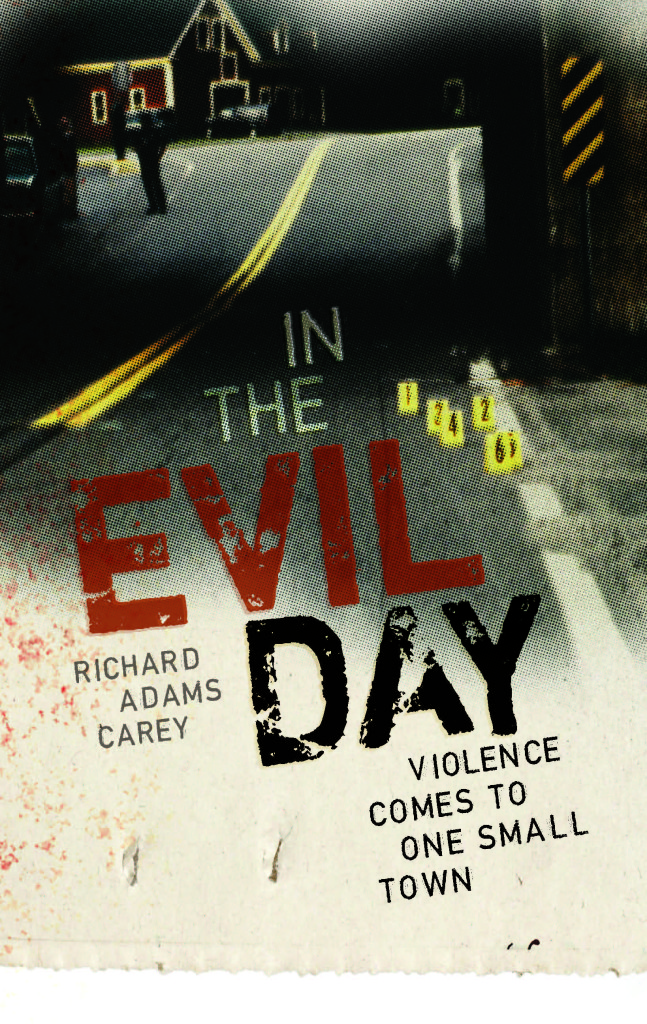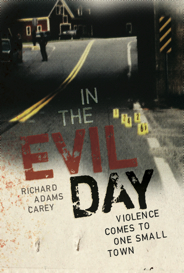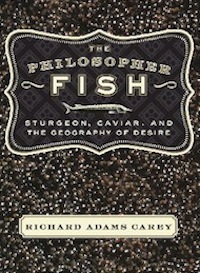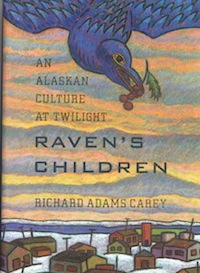
In the Evil Day: Violence Comes to One Small Town
ForeEdge (an imprint of the University Press of New England), 2015
If you go far enough north in New Hampshire, all the way to the headwaters of the Connecticut River and within hailing distance of Canada, you come to the little town of
Colebrook. On the corner of Bridge Street and Main you’ll find the one-story building that houses the News and Sentinel, the weekly newspaper that still serves that high part of the North Country.
In the weeks and months following August 19, 1997, that newspaper was swamped with letters to the editor that came from all over the United States, and in fact all over the world—from people in Europe, Africa, South America. “At times like this,” one person wrote, “I am reminded that inside each of us is an enormous unanswered question.”
That question is this—what would you do if suddenly, in the course of an ordinary day, you found yourself, your friends, your loved ones in mortal danger?
Most of us live our lives never having to confront that question. But hundreds of people in the North Country faced it that day in the course of a shooting rampage distinctly different from the Columbine/Virginia Tech/Aurora/Newtown variety.
There was no random gunfire here, and only four victims. Each of those victims had a role in the community (and a back story) that in some way delivered them inevitably to their fate. The perpetrator was not a young psychotic, but a 62-year-old carpenter, probably sane, who had fought town officials for twenty years on property rights issues. Carl Drega was more domestic terrorist than mass-murderer.
There were five different crime scenes in the course of an afternoon that unfolded with enough twists and turns for the plot of a novel. One was the News and Sentinel building, where the newspaper’s editor was murdered. Also killed there was Vickie Bunnell, a 45-year-old woman who was a lawyer, a judge, and the love interest of John Harrigan, owner of the News and Sentinel and New England’s most prominent outdoors columnist. The paper was due out the next morning. Harrigan marshaled the shocked remnants of his staff, reported on the events of the day, and the next morning delivered to the newsstands an issue of the News and Sentinel that would be nominated for a Pulitzer Prize.
Much of the special power of this event—fueling not only Harrigan’s story, but subsequent features in the New York Times, TIME Magazine, Newsweek, and LIFE—lies in the courage, grace, and presence of mind displayed by so many of the ordinary citizens who were swept up into the maelstrom. As one letter-writer, Ekeanyanwn Chukwudi of Owerri, Nigeria, wrote: “I love you all in America—your values, democracy, human rights, and all that the Stars and Stripes stands for. God bless America.”
That version of the story, however, skimmed merely the surface of the day’s drama, and its ominous prelude, and its poignant aftermath. In the Evil Day is the complete story of one certain day in small-town America. Mr. Chukwudi will be even more impressed.
The world at large has mostly forgotten about the 1997 Colebrook shootings, but in New Hampshire the incident remains the state’s version of the Kennedy assassination—almost everybody remembers where they were and what they were doing when first they heard about it.
I was home in Sandwich, a town about the size of Colebrook, but south of the notches in the White Mountains, in central New Hampshire,. It scared me to think how easily something like that could happen in Sandwich, or any small rural town. But I didn’t think a lot more about it. I was working on Against the Tide at the time. Then came The Philosopher Fish.
The story wouldn’t leave me alone, though. Once I began digging into it, and learning more of the surprising details, I saw how in many ways it was a story unique and particular to the North Country—and at the same time deeply rooted in both the best and the worst in human nature. Like a murder retold in an old ballad, it’s a story with mythic stature.
I’ve been working on this, more or less, since 2001. This is the first book I’ve done without a contract in hand because I realized there was no way that I could forecast when the research would be done and when the manuscript would be ready.
And the research was tricky. It had to begin with earning a degree of trust, since I didn’t know anyone in Colebrook. The project never would have gotten off the ground had not Earl and Irene Bunnell—the parents of Vickie—agreed to meet with me several times, and correspond with me, and finally consent to be interviewed. Eventually they fed me and put me up in Vickie’s old room any time I needed to stay overnight for other interviews. Bunny taught me what little I know about fly-fishing, and when he died in 2011, I felt like I had lost a father. Irene, bless her, is doing well.
Others agreed to speak with me once the Bunnells were on board. Some have continued to refuse. Well, it’s hard for all of them. I ended up doing something like three hundred interviews, and more than a few—after all these years—were accompanied by tears, these from witnesses and survivors of both genders. There are some catastrophes that resist what we call “healing” or “closure.” Like an amputee, you endure it as best you can and move on. But the good news is that we wouldn’t grieve so hard if we didn’t love so well.
It’s a great and powerful story, as rich in beauty and grace as it is in terror and grief. I’m glad it chose me.
An excerpt: How it begins…
It’s just a small New Hampshire town, 2,500 souls or so, but still—there should have been portents, signs more universal than personal, omens more public than the terror that Vickie Bunnell kept almost entirely to herself, or the hunch that state trooper Scott Phillips had that the situation with Carl Drega had entered a darker phase.
There should have been a blood moon over Monadnock, or a noonday owl calling from a cornice on Colebrook’s Main Street, or unnatural births among North Country dairy herds.
There should have been something like the celestial theater performed over Titus Hill in the early years of the Civil War. “It happened on a dull overcast day, as the farmers of Titus Hill and Columbia cast a weather eye at the clouds and hurried to get the hay in ahead of the oncoming storm,” wrote physician and Colebrook historian Dr. Herb Gifford. “Suddenly the clouds parted and there in the sky was a great battle in progress—hundreds of men, horses, and guns in a massive struggle. This phenomenon was reported by at least 21 people scattered from Titus Hill to Columbia, and all claimed to have seen it at the same time.”
There was nothing like that in 1997—only an odd little incident recalled in a one-column story in a corner of the August 13th edition of the News and Sentinel newspaper. On Friday the 8th, a man from Columbia, a town of 700 just south of Colebrook, had gotten into an argument at a grocery store with a couple driving a van bearing North Carolina plates. The van followed the Columbia man to his home on Bungy Road. Then five shotgun blasts were fired into the house as the van—sporting a “Tennessee Volunteers Militia” bumper sticker—drove back and forth on the road in front. The homeowner returned fire with an unspecified weapon. “Although several state police units responded,” wrote reporter Claire Lynch, “the van could not be found.”
That Columbia man was not Carl Drega, who would not have called the state police for help in any event, and the incident has no known relationship, direct or otherwise, to the events of Tuesday, August 19, 1997. It was just a sort of noonday owl.






